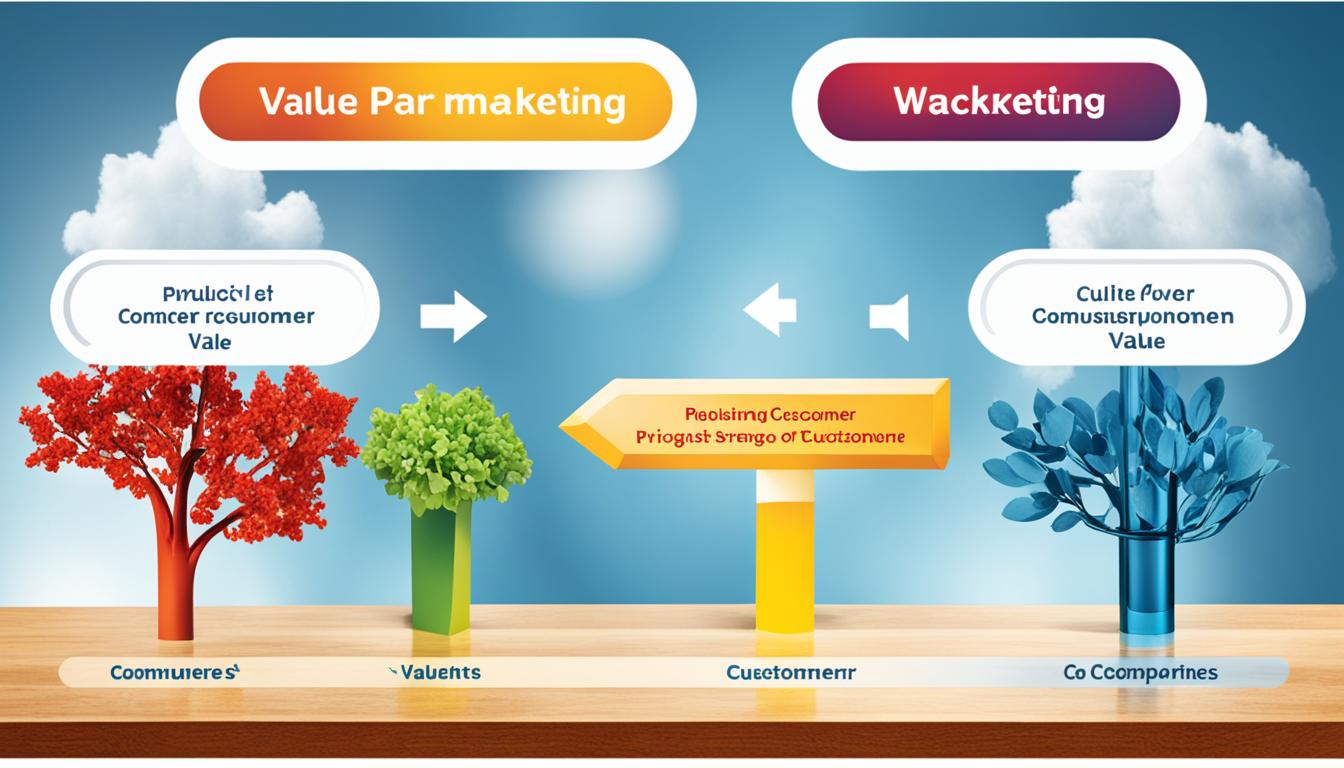Payer marketing, also known as value and access, is a function that falls under market access and is responsible for developing the payer communications strategy for a specific brand. They work closely with internal partners to ensure consistent messaging and brand strategy. Payer marketing teams determine the access strategy, prioritize favorable formulary positioning, and track execution and forecast. They may also collaborate with HEOR colleagues to develop tools for account teams and ensure alignment with materials for the field medical payer team.
Key Takeaways
- Payer marketing, or value and access, is a crucial function in the healthcare industry.
- Payer marketing teams develop communications strategies for specific brands.
- They prioritize formulary positioning and work closely with internal partners.
- Payer marketing teams collaborate with HEOR colleagues to develop tools.
- Payer marketing plays a vital role in ensuring access and success in the market.
The Evolution of Payer Marketing
Payer marketing has undergone a significant evolution in recent years, transitioning from its traditional focus on trade negotiations and payer value proposition to a more strategic and challenging approach. The healthcare landscape has witnessed the consolidation of power among payers, leading to increased competition and a heightened emphasis on value and outcomes. As a result, payer marketers have had to adapt their strategies and tactics to keep pace with these dynamic changes.
One key aspect of this evolution is the increasing importance of providing robust inputs earlier in the decision-making process. Payer marketers now play a crucial role in shaping the access strategy of a brand, influencing formulary positioning, and aligning messaging with the overall brand strategy. This requires a deep understanding of the payer landscape and the ability to decode the complexities of customer needs and preferences.
Furthermore, the COVID-19 pandemic has accelerated the adoption of virtual engagement with payers and other access influencers. Payer marketers have had to embrace digital platforms and remote interactions to ensure effective communication and engagement. This shift towards virtual engagement has opened up new opportunities for payer marketers to showcase their expertise and build relationships in a rapidly changing environment.
Successful payer marketing strategies now revolve around driving timely decision-making, decoding customer complexities, and embracing a customer-centric approach. Payer marketers need to leverage data and analytics to gain insights into payer behaviors and preferences. By understanding the needs and challenges of their target audience, payer marketers can develop tailored strategies and tactics to deliver value and drive positive outcomes.
In summary, the evolution of payer marketing has necessitated a shift towards more strategic and customer-centric approaches. Payer marketers must adapt to the changing landscape, leverage digital platforms for engagement, and focus on driving timely and informed decision-making. By staying abreast of payer marketing trends and employing innovative strategies, payer marketers can position themselves for success in the ever-evolving healthcare industry.
| Payer Marketing Strategies | Payer Marketing Tactics | Payer Marketing Trends |
|---|---|---|
| 1. Early engagement with payers | 1. Virtual engagement through digital platforms | 1. Increased focus on value and outcomes |
| 2. Tailored messaging and value proposition | 2. Data-driven decision-making | 2. Embracing customer-centricity |
| 3. Collaborative partnerships with payers | 3. Leveraging analytics for payer insights | 3. Integration of digital technologies |
| 4. Strategic formulary positioning | 4. Decoding customer complexities | 4. Adoption of virtual engagement |
The Role of Payer Marketing in the Healthcare Landscape
Payer marketing plays a crucial role in the healthcare landscape by collaborating with providers, employers, government entities, and other stakeholders to optimize members’ health and well-being. With a focus on delivering a cohesive brand experience, payer marketing teams help position the payer as an industry leader.
To achieve success, payer marketing solutions are implemented to ensure integrated member experiences and internal alignment that mirror the member and group experience. Measurement and improvement, along with leveraging data analytics, are key components of payer marketing strategies. These solutions enable payer marketing teams to make informed decisions based on insights gained from payer market research.
In addition to developing effective strategies, payer marketing campaigns can be created in collaboration with a payer marketing agency. These agencies provide expertise and support in executing multi-channel and targeted campaigns, enabling payers to reach their desired audience effectively.
Overall, payer marketing plays a significant role in navigating the complex healthcare landscape, driving member engagement, and ultimately contributing to the success of payers in the market.
The Benefits of Payer Marketing Solutions:
- Enhanced member engagement through integrated experiences
- Consistent brand messaging and positioning
- Improved internal alignment and coordination
- Data-driven decision-making through analytics
Payer Marketing Campaigns and Payer Market Research:
Payer marketing campaigns are a critical component of payer marketing efforts. These campaigns are designed to raise awareness, educate, and engage the target audience. By partnering with a payer marketing agency, payers can leverage the agency’s expertise in developing and executing impactful campaigns across multiple channels.
Payer market research provides valuable insights into payer behaviors, preferences, and market trends. This research helps shape payer marketing strategies, ensuring they align with the needs and expectations of payers and other stakeholders.
By utilizing payer marketing solutions, collaborating with payer marketing agencies, and leveraging payer market research, payer marketing teams can successfully navigate the healthcare landscape and achieve their goals.
Building a Powerful Payer Marketing Structure
To achieve payer marketing success, organizations need to focus on building a powerful marketing structure. This involves integrating the member experience and improving coordination of communication channels. The internal structure should mirror the member and group experience, ensuring alignment between departments. Payer marketing organizations should measure and improve targeted marketing campaigns and transform into marketing data organizations. Emphasizing measurable results, improving member communications, and addressing shifting payer/access dynamics are essential for achieving payer marketing success.
Integrating the Member Experience
In order to build a powerful payer marketing structure, organizations should prioritize integrating the member experience. This means understanding the needs and preferences of the target audience and tailoring marketing efforts to meet those expectations. By providing a seamless and personalized experience, payer marketing teams can effectively engage members and drive loyalty.
Improving Coordination of Communication Channels
Effective communication is key to payer marketing success. Organizations should strive to improve coordination among communication channels to ensure consistent and impactful messaging. By aligning marketing efforts across channels such as email, social media, and direct mail, organizations can deliver a cohesive brand experience and maximize the impact of their campaigns.
Measuring and Improving Targeted Marketing Campaigns
Analyze and optimize marketing campaigns to improve effectiveness and achieve payer marketing success. By tracking key metrics such as conversion rates, click-through rates, and engagement levels, organizations can identify opportunities for improvement and make data-driven decisions. Continuous improvement is essential to stay ahead in a competitive healthcare market.
Transforming into Marketing Data Organizations
To harness the power of data in payer marketing, organizations should strive to become marketing data organizations. This involves investing in robust data analytics capabilities and leveraging insights to drive marketing strategies. By understanding member behavior, preferences, and patterns, payer marketers can develop targeted campaigns that resonate with their audience and deliver measurable results.
Emphasizing Measurable Results
To achieve payer marketing success, organizations must prioritize measurable results. By setting clear goals and tracking key performance indicators (KPIs), such as member satisfaction, acquisition rates, and revenue growth, payer marketers can demonstrate the value of their efforts and make data-driven decisions.
| Benefits of a Powerful Payer Marketing Structure | Actions |
|---|---|
| Improved member experience and engagement | Integrate member experience across all touchpoints |
| Consistent and impactful messaging | Coordinate communication channels and develop a cohesive brand experience |
| Data-driven decision-making | Measure and analyze targeted marketing campaigns |
| Optimized resource allocation | Transform into marketing data organization and leverage insights |
| Tangible results and ROI | Emphasize measurable results and track key performance indicators (KPIs) |
Overcoming Challenges in Payer Marketing
Payer marketing teams face various challenges in effectively addressing the constantly shifting payer and access dynamics. These challenges often act as barriers to achieving success in payer marketing efforts. Some of the key challenges that payer marketing teams grapple with include:
- Driving timely decision-making
- Decoding customer complexity
- Adapting to rapidly changing landscapes, such as during the COVID-19 pandemic
- Lack of cross-functional coordination, miscommunication, and misalignment
These challenges can hinder the efficacy of payer marketing strategies and impede the delivery of desired outcomes. However, innovative approaches and strategic solutions can help overcome these challenges to ensure successful payer marketing campaigns. Overcoming these challenges involves:
- Adopting a strategic and customer-centric approach
- Engaging with payers early in the decision-making process
- Quickly adapting to shifts in market dynamics
By incorporating these strategies, payer marketing teams can navigate the challenges associated with a rapidly evolving healthcare landscape, optimize access strategies, and drive successful payer marketing campaigns.
Common Challenges in Payer Marketing
| Challenge | Description |
|---|---|
| Driving timely decision-making | Payer marketing teams often struggle with influencing payers to make timely decisions on formulary positioning, coverage, and reimbursement, which can impact market access and brand performance. |
| Decoding customer complexity | The complexity of payer organizations and their decision-making processes poses challenges in understanding and effectively addressing their needs, preferences, and priorities. |
| Adapting to rapidly changing landscapes | The ever-evolving healthcare landscape, including regulatory changes, market shifts, and emerging technologies, requires payer marketing teams to stay agile and adapt their strategies accordingly. |
| Lack of cross-functional coordination, miscommunication, and misalignment | Inconsistent communication among cross-functional teams and misalignment between departments can hinder the development and execution of cohesive payer marketing strategies. |

The Importance of Payer Marketing in Pharma
Payer marketing plays a crucial role in the pharmaceutical industry, specifically within the managed care setting. Pharma payer marketers have a significant responsibility in articulating the payer value proposition, negotiating terms of trade, and providing essential inputs for pipeline and M&A decision-making. They navigate a constantly changing market landscape that is characterized by the consolidation of power, increased competition, and a focus on value and outcomes.
Successful payer marketing in pharma requires cross-functional coordination, early engagement with payers, and a deep understanding of market dynamics. By collaborating with internal partners and staying abreast of industry trends, pharma payer marketers are able to effectively position their brands and secure favorable formulary positioning.
Furthermore, payer marketers must stay informed about the evolving payer landscape, including changes in reimbursement policies and healthcare regulations. This knowledge allows them to effectively communicate the value of their products to payers and ensure market access.
Ultimately, payer marketing in the pharmaceutical industry is a key driver of market success. By championing the payer value proposition, payer marketers contribute to the overall growth and profitability of pharmaceutical companies.
The Role of Payer Marketing in Pharma
Pharma payer marketers play a crucial role in shaping the access and reimbursement strategies for their brands. They work closely with internal stakeholders to ensure consistent messaging and brand strategies across all payer communications. By understanding the needs and preferences of payers, payer marketers can develop effective value propositions and negotiation strategies.
The Challenges and Opportunities in Payer Marketing
Payer marketing in pharma comes with its own set of challenges. The evolving healthcare landscape, regulatory changes, and increasing cost pressures require payer marketers to be adaptable and innovative. However, these challenges also present opportunities for payer marketers to differentiate their brands and drive value for both payers and patients.
By leveraging data analytics and patient insights, payer marketers can identify trends, anticipate payer needs, and develop targeted strategies that align with market dynamics. Effective payer marketing strategies can not only improve market access but also foster strong relationships between pharmaceutical companies and payers.
The Future of Payer Marketing
The future of payer marketing holds immense potential for growth and innovation, as the healthcare landscape continues to evolve and consumer expectations shift. To stay ahead of the curve, payer marketing teams need to embrace new marketing philosophies, structures, and programs that align with the needs of today’s consumers. Here are some key trends to watch out for:
1. Leveraging Data Analytics
Data analytics will play a crucial role in the future of payer marketing. By harnessing the power of data, payer marketing teams can gain valuable insights into consumer preferences, behavior patterns, and market trends. This data-driven approach allows them to make informed decisions, optimize marketing strategies, and improve outcomes.
2. Embracing Customer-Centric Approaches
In the future, payer marketing will be centered around delivering exceptional customer experiences. By understanding the unique needs and preferences of consumers, payer marketing teams can tailor their messaging, products, and services accordingly. Building strong relationships with consumers through personalized interactions and targeted campaigns will be essential for success.
3. Collaborative Partnerships
Payer marketing teams will increasingly collaborate with other stakeholders in the healthcare industry to drive mutually beneficial outcomes. By forming strategic partnerships with providers, pharmaceutical companies, and other industry players, payer marketing teams can create comprehensive solutions that address the challenges and opportunities of the evolving healthcare landscape.
4. Early Engagement with Payers
In order to navigate the complex payer landscape, payer marketing teams must engage with payers early in the decision-making process. By understanding payer needs, priorities, and requirements, payer marketing teams can develop tailored strategies and solutions that meet their expectations. This proactive approach will help build strong relationships, drive positive outcomes, and ensure market access.

| Benefits of Embracing the Future of Payer Marketing | Challenges to Overcome |
|---|---|
|
|
The Impact of Payer Marketing on Healthcare Market Success
Payer marketing plays a significant role in shaping healthcare market success. By developing effective payer communications strategies, payer marketing teams can drive favorable formulary positioning and ensure consistency in messaging. Integrated member experiences, improved member communications, and targeted marketing campaigns can enhance overall healthcare market success. Payer marketing success is measured through metrics such as member satisfaction, improved health outcomes, and net promoter scores.
When payer marketing teams develop compelling communications strategies, they can effectively engage payers and influence their decisions regarding formulary positioning. By articulating the value proposition of a brand, payer marketers can highlight the benefits and cost-effectiveness of specific healthcare solutions. This strategic positioning can lead to increased access and coverage for the brand, ultimately contributing to its success in the healthcare market.
An integral aspect of payer marketing’s impact on healthcare market success is the creation of integrated member experiences. Payer marketing teams work collaboratively with various stakeholders, including providers, employers, and government entities, to optimize members’ health and well-being. By delivering a cohesive brand experience across various touchpoints, payer marketers can enhance member satisfaction and loyalty, ultimately driving market success.
Payer Marketing Success Metrics
Payer marketing success is measured using various metrics that reflect the impact on healthcare market success. Member satisfaction is a key indicator of payer marketing effectiveness, as satisfied members are more likely to remain with a payer and utilize their services. Additionally, payer marketing efforts that result in improved health outcomes, such as increased medication adherence or reduced hospital readmissions, contribute to overall healthcare market success. Net promoter scores, which measure customers’ likelihood to recommend a brand, can also provide insights into the effectiveness of payer marketing strategies.
The impact of payer marketing on healthcare market success cannot be overstated. By developing effective communications strategies, creating integrated member experiences, and focusing on metrics that reflect success, payer marketing teams can drive positive outcomes in the healthcare marketplace.
Conclusion
Payer marketing is a critical function in the healthcare industry, responsible for driving access, value, and success in the market. In today’s evolving landscape, payer marketing teams must adopt a customer-centric approach and focus on integrated member experiences to deliver meaningful results. By leveraging data analytics, payer marketers can gain valuable insights to inform their strategies and effectively navigate market dynamics.
Embracing new marketing philosophies is essential for payer marketing success. With the healthcare industry undergoing significant changes, payer marketers must adapt their strategies to meet the demands of the market. This includes staying up-to-date with emerging trends and technological advancements that can enhance their marketing efforts.
Building strong internal partnerships is crucial for payer marketing success. Collaboration between departments ensures alignment and allows for a cohesive brand experience. By working closely with internal stakeholders, payer marketers can develop and execute strategies that drive favorable formulary positioning and deliver consistent messaging.
With the right strategies and tactics, payer marketing has the potential to shape the future of healthcare market success in the United States and beyond. Payer marketers play a vital role in driving access to healthcare services, while also prioritizing value for patients and payers alike. As the healthcare landscape continues to evolve, payer marketing will remain an integral part of the industry, driving innovation and delivering positive outcomes.
FAQ
What is payer marketing?
Payer marketing, also known as value and access, is a function that falls under market access and is responsible for developing the payer communications strategy for a specific brand.
How has payer marketing evolved?
Payer marketing has evolved from primarily negotiating terms of trade to becoming more strategically focused and challenging, with increased competition and attention to value and outcomes.
What role does payer marketing play in the healthcare landscape?
Payer marketing collaborates with stakeholders to optimize members’ health and well-being, delivering a cohesive brand experience and positioning the payer as an industry leader.
How can organizations achieve payer marketing success?
Organizations can achieve payer marketing success by building a powerful marketing structure, integrating member experiences, and improving coordination of communication channels.
What challenges do payer marketing teams face?
Payer marketing teams face challenges such as driving timely decision-making, decoding customer complexity, and adapting to a rapidly changing landscape, among others.
What is the importance of payer marketing in pharma?
Payer marketing in pharma involves articulating the payer value proposition, negotiating terms of trade, and providing critical inputs for decision-making in the industry.
What does the future of payer marketing look like?
The future of payer marketing lies in embracing new marketing philosophies, adapting to emerging trends, and leveraging data analytics for measurement and improvement.
How does payer marketing impact healthcare market success?
Payer marketing impacts healthcare market success by driving access, value, and consistent messaging, leading to improved member satisfaction and health outcomes.
What is the conclusion on payer marketing?
Payer marketing plays a critical role in shaping healthcare market success and requires a customer-centric approach, strong internal partnerships, and adaptation to market dynamics.








